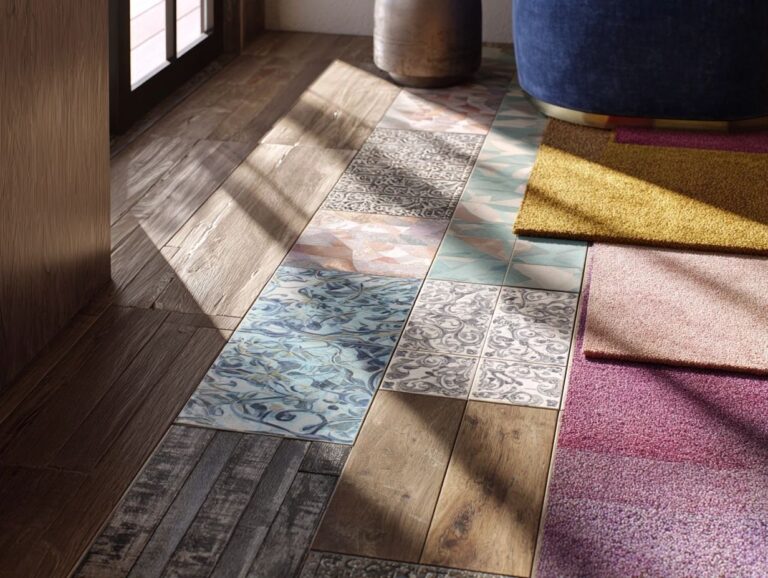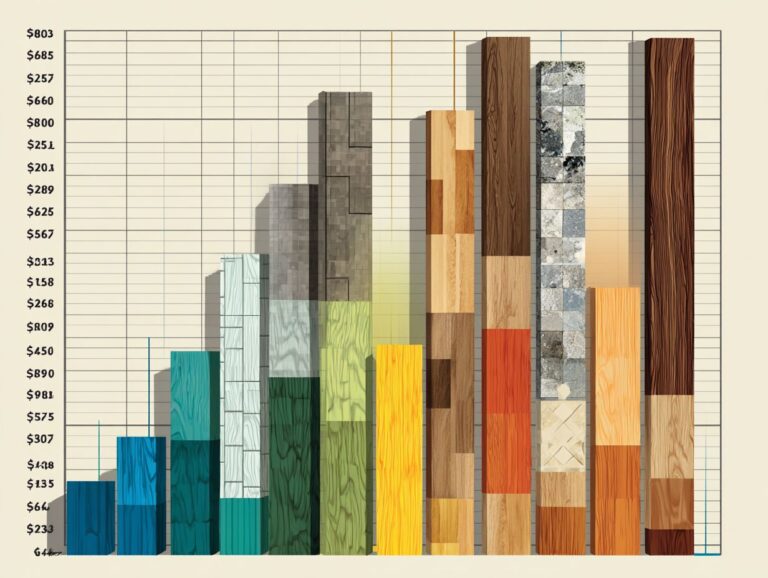Floor Leveling Compounds – Types and Applications
Uneven flooring can be a significant concern, especially in older homes. Knowing about different floor leveling materials, like self-leveling underlayment, is important for getting a flat and stable surface. At EWI Store, East Coast Flooring, and ATR Floors, you’ll find a variety of options customized for you. In this article, we’ll look at the different kinds of these compounds and how they are used, so you can make the most of your flooring project.
Key Takeaways:
Contents
- Types of Floor Leveling Compounds
- Floor Leveling Compounds Market Analysis
- U.S. Self-Leveling Concrete Market: Market Value Growth
- U.S. Self-Leveling Concrete Market: Market Segmentation
- Global Flooring Leveling Compound Market: Market Value Growth
- Global Flooring Leveling Compound Market: Regional Market Shares
- Cement-based Leveling Compounds
- Gypsum-based Leveling Compounds
- Self-Leveling Compounds
- Polymer-modified Leveling Compounds
- Applications of Floor Leveling Compounds
- Factors to Consider When Choosing a Leveling Compound
- Installation Process of Floor Leveling Compounds
- Common Issues and Troubleshooting
- Frequently Asked Questions
- What are floor leveling compounds and what are they used for?
- What are the different types of floor leveling compounds?
- Can floor leveling compounds be used on any type of flooring?
- How do I apply floor leveling compounds?
- How long does it take for floor leveling compounds to dry?
- What are the benefits of using floor leveling compounds?
What are Floor Leveling Compounds?
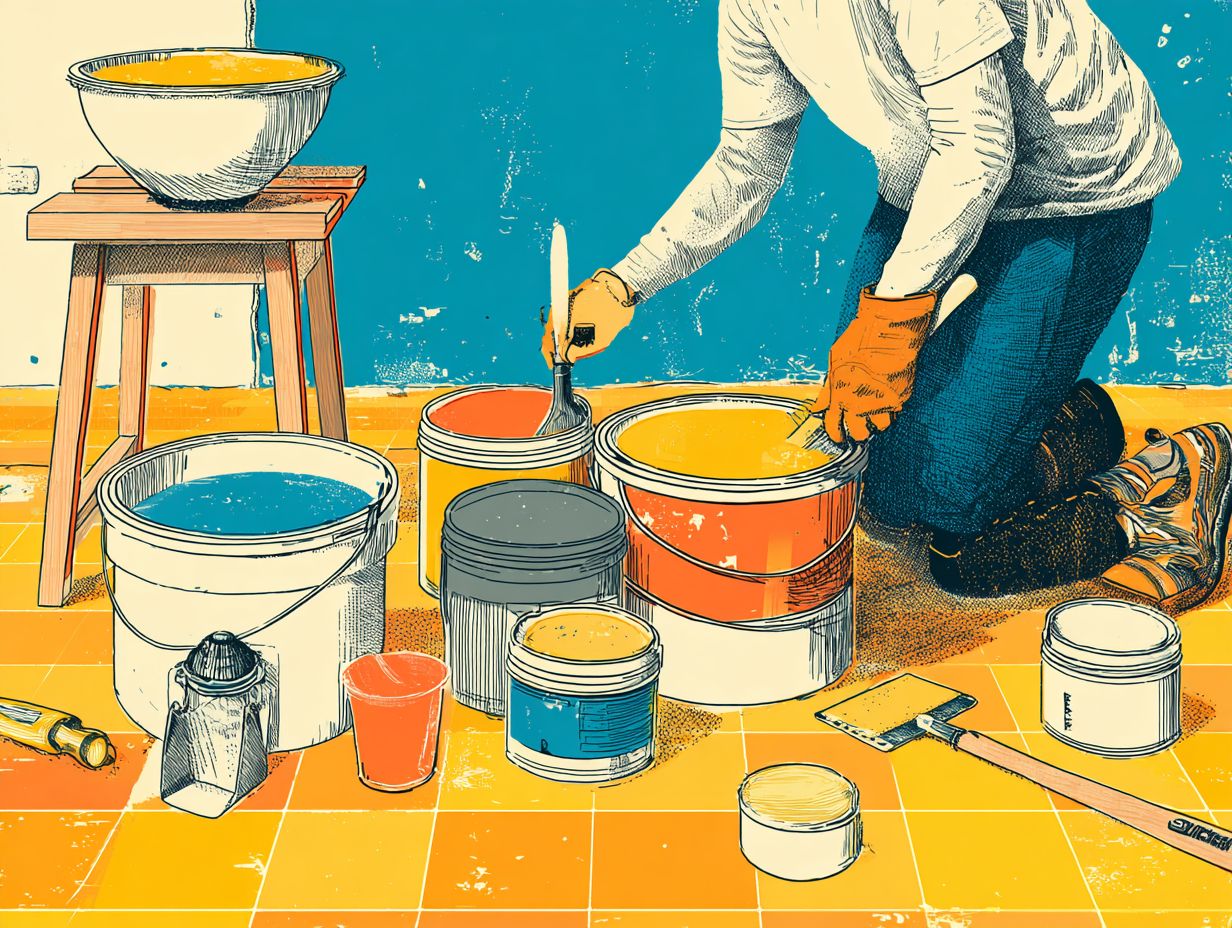
Floor leveling compounds are used to make uneven floors smooth, such as concrete and wood joists, which makes them suitable for different flooring projects.
These compounds usually include a mix of cement, small particles, and polymer additives to improve sticking and flexibility.
For example, self-leveling underlayment is often applied before putting down hardwood or tile floors. It creates an even surface that helps stop cracks from happening later.
Before starting, make sure the subfloor is clean and ready so it sticks well.
Brands like Henry’s 555 or MAPEI’s self-leveling compounds are popular choices, catering to both residential and commercial applications. They usually dry within a few hours, making them helpful for quick renovations.
Importance of Floor Leveling
Correct floor leveling is important for keeping the quality and look of any floor installation, and it helps avoid problems with uneven surfaces later on.
Neglecting floor leveling can lead to serious consequences. For instance, an unlevel surface can cause tiles to crack, resulting in costly repairs-upwards of $1,000 in some cases.
Statistical data shows that homes with uneven floors face a 15% increase in maintenance costs. To get a flat surface, try using a self-leveling compound or a laser level.
These help identify high and low spots, facilitating a smoother installation process. Handling this step early safeguards your floors and raises your property’s value.
Types of Floor Leveling Compounds
Knowing the different kinds of floor leveling compounds helps you choose the correct one for your flooring situation.
Floor Leveling Compounds Market Analysis
Additionally, understanding common flooring installation mistakes can further enhance your flooring projects. Worth exploring: Common Flooring Installation Mistakes and How to Avoid.
Floor Leveling Compounds Market Analysis
U.S. Self-Leveling Concrete Market: Market Value Growth
U.S. Self-Leveling Concrete Market: Market Segmentation
Global Flooring Leveling Compound Market: Market Value Growth
The Floor Leveling Compounds Market Analysis provides important information about the U.S. and international markets. It offers detailed information on market value growth, division into categories, and regional shares, which are important for stakeholders to grasp industry patterns and potential growth areas.
U.S. Self-Leveling Concrete Market shows significant growth potential from $1.02 billion in 2024 to $1.67 billion by 2032, with a compound annual growth rate (CAGR) of 6.3%. This growth is driven by increasing construction activities and the demand for smooth, leveled flooring solutions.
- The Polymer-Based Segment is projected to hold a 58.6% share in 2025, indicating its popularity due to superior performance characteristics.
- The Commercial Segment is expected to account for 46.1% of the market in 2025, driven by office spaces, retail stores, and other commercial buildings requiring durable flooring solutions.
- New Construction will represent 54.7% of the market in 2025, highlighting growth in new infrastructure projects.
- The Underlayment Segment will capture a 60.3% share in 2025, as these compounds are critical for preparing floors before installing final coverings.
- The Residential Segment is forecasted to grow at a CAGR of 7.24% from 2025 to 2032 showing strong interest in home improvements and construction of new homes.
- The Renovation Segment is poised for a CAGR of 7.41% between 2025 and 2032, driven by the need for updating and maintaining existing structures.
The Global Flooring Leveling Compound Market is set to expand from $5.2 billion in 2024 to $8.7 billion by 2033, with a CAGR of 5.8%. This growth is fueled by rising construction activities worldwide and advancements in flooring technologies.
- The Asia Pacific region is projected to dominate with a 41% market share in 2024, driven by rapid urbanization and infrastructure development in countries like China and India.
- North America will account for a market value of $1.3 billion in 2024, supported by growing residential and commercial construction projects.
- Europe will hold a market value of $1.1 billion in 2024, reflecting steady demand for floor leveling solutions in both renovation and new construction projects.
In summary, the Floor Leveling Compounds Market Analysis shows strong growth potential in both U.S. and international markets. Key drivers include increasing construction activities, the need for advanced flooring solutions, and significant opportunities in residential and renovation segments. Reports show that the Asia Pacific market is strong, while North America and Europe are growing steadily.
Cement-based Leveling Compounds

Cement-based leveling compounds are durable and tough, suitable for areas with frequent use, like houses and commercial spaces.
These compounds, such as those offered by EWI Store, typically have applications in floor preparation and repair, ensuring a smooth surface for flooring installations.
To mix, follow a simple ratio: combine the compound with clean water, adhering to the manufacturer’s specifications. Curing usually takes about 24 to 48 hours, which is essential for achieving optimal strength.
To get the best outcome, make sure the application surface is clean and free of debris before pouring the compound. This helps it stick well and last a long time.
Gypsum-based Leveling Compounds
Gypsum-based leveling compounds offer quick drying times and are often used for interior applications where a smooth finish is required.
These compounds are ideal for use over concrete, wood, or existing flooring, creating a solid base for finishes such as tile or carpet. They adhere strongly and can hold various weights, making them suitable for homes and small businesses.
Remember that gypsum-based compounds cannot be used in places that get a lot of moisture, such as bathrooms or basements. In such cases, consider alternatives like polymer-modified self-leveling compounds that can withstand damp conditions.
Self-Leveling Compounds
Self-leveling compounds are designed for rapid application and ease of use, allowing homeowners and contractors to achieve a level surface without extensive labor.
These compounds work on various surfaces such as concrete, plywood, and tile, making them suitable for many projects.
To get the best results, make sure the surface is clean and has no debris before you apply.
Popular products like Henry 555 Level Pro and Mapecem Premix offer excellent adhesion and can be installed quickly.
It’s advisable to mix these compounds according to the manufacturer’s instructions and pour them in small sections to maintain evenness.
With the right preparation and product choice, achieving a perfect level floor is simplified.
Polymer-modified Leveling Compounds
Leveling compounds with added polymers are more flexible and resist moisture better, suitable for areas with varying humidity.
These compounds are particularly useful in both residential and commercial settings.
For instance, MAPEI’s Ultraplan 1 Plus is perfect for light residential applications due to its quick-setting nature, while Ardex K 301 offers exceptional performance for heavier loads in commercial environments.
For installations over radiant heat systems or in basements, use Sika’s Level-125 for best stickiness and strength.
Always consider the specific project needs-choose based on traffic expectations and environmental conditions to maximize performance.
Applications of Floor Leveling Compounds
Floor leveling compounds are useful products applied in different places, from homes to factories, to create an even surface for floor materials.
Residential Applications
In residential properties, leveling compounds are typically used to prepare uneven subfloors before installing hardwood, tile, or laminate flooring.
Before using leveling compounds, check the condition of the subfloor. For instance, if you have dips exceeding 1/4 inch, choose a self-leveling compound, like Henry 555, which can level up to 1 inch in a single application.
Before pouring, make sure the surface is clean and has a primer that helps it stick well. Mix the compound following the manufacturer’s instructions, and pour it in a continuous flow to avoid cold joints. Always allow adequate curing time, usually 24 hours, before installing your flooring.
Commercial Applications
In commercial settings, floor leveling compounds are essential for ensuring the durability and longevity of flooring installations in high-traffic areas.
A good compound can make the floor much more durable against heavy use. For example, self-leveling compounds such as SikaLevel or Arditex NA can be applied easily to create a smooth base, ensuring even wear over time.
Think about how fast it dries and how much weight it can hold; for example, SikaLevel 125 dries quickly and can handle heavy weights, so it works well in warehouses.
Correct application methods, including cleaning the surface and using the right primers, are important for the best result.
Industrial Applications
In industrial settings, floor leveling compounds are used on concrete surfaces that need to support heavy weights and harsh environments.
For best results, pick materials that meet these standards: compressive strength should be more than 4,000 psi to handle heavy weights, and flexibility is important for areas with changes in temperature.
For example, self-leveling compounds like ARDEX K 301 provide excellent durability, while those like MAPEI Ultraplan 1 Plus are known for their quick drying time and ease of use.
Always assess the substrate condition and required finish, as this will guide your selection process and help maintain the integrity of your flooring over time.
Factors to Consider When Choosing a Leveling Compound
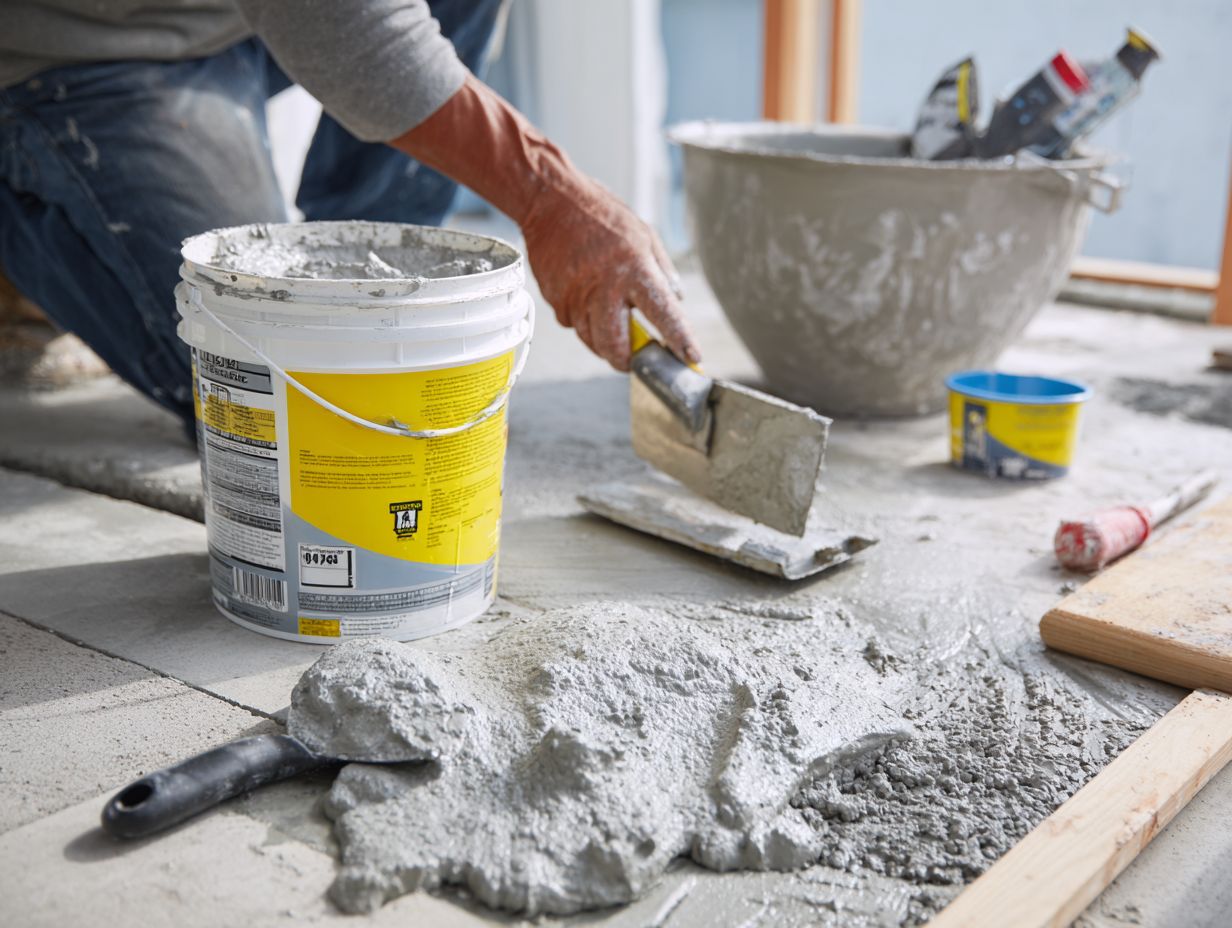
Selecting the correct leveling compound is important for successful flooring projects, and many things can affect this choice. To avoid potential pitfalls, it’s essential to understand common flooring installation mistakes that could compromise your efforts.
Subfloor Material
The subfloor material plays a significant role in determining the appropriate leveling compound, as different materials have varying compatibility.
For wooden subfloors, a latex-based leveling compound is ideal, as it provides flexibility and adheres well. In contrast, concrete subfloors require a cement-based compound, which offers excellent durability and moisture resistance.
For example, if the concrete is uneven, using a self-leveling compound like Ardex K 15 can make application easier and create a smooth surface.
Always make sure the subfloor is clean and dry before you apply any leveling compound. This helps the compound stick better and reduces problems.
Moisture Levels
Evaluating moisture levels is essential, as some leveling compounds offer better moisture resistance than others, which can impact installation and longevity.
To assess moisture levels effectively, you can use methods like the calcium chloride test, which measures moisture vapor emissions, or the moisture meter approach for quick readings.
For example, a calcium chloride kit costs around $30 and is highly reliable for concrete flooring. Knowing your moisture levels guides you in selecting the right leveling compound.
For areas that often get damp, think about using leveling compounds such as Mapei self-leveling compound. It is made for places with a lot of moisture and provides a strong and lasting floor for many years.
Traffic Type and Volume
The kind and amount of traffic a floor will experience affects the choice of a proper leveling compound to make sure it works well.
For example, in light residential areas, a standard self-leveling compound may suffice, providing a smooth finish for homes with minimal wear.
In heavy commercial settings, stronger compounds like those fortified with polymers are essential, as they can withstand significant foot traffic and weight from equipment.
When choosing a product, consider those rated for commercial use, such as:
- Ardex K 15
- Mapei Planiprep
These products last longer and resist water, making them good for harsh conditions.
Installation Process of Floor Leveling Compounds
Leveling floors with compounds needs proper preparation and application to get the best results, as detailed in our Subfloor Preparation – Leveling and Repair Guide.
Preparation of the Subfloor
Preparing the subfloor is the first, and perhaps the most critical step, in the installation process of leveling compounds, as it directly affects adhesion and performance.
Start by cleaning the surface thoroughly; remove any dust, debris, and old adhesives using a vacuum or stiff broom.
Next, inspect for unevenness; use a level to identify low spots or bumps. For minor issues, a floor scraper can help, while larger imperfections may require patching with a cement-based compound.
This initial assessment and preparation should take about 1-2 hours, ensuring a solid foundation for your leveling compounds and maximizing the longevity of your floor installation.
Mixing the Compound
Mixing the leveling compound correctly is essential for ensuring consistency and performance, whether using latex-based or epoxy-based formulations.
To achieve the right consistency, start with a clean mixing container and use a power mixer.
For latex-based mixtures, the usual mix is 1 part water to 5 parts compound-be sure to pour the water in before the compound. For epoxy compounds, follow the manufacturer’s instructions, as ratios can vary.
Avoid common mistakes such as not mixing thoroughly, which can lead to weak spots, or using tools that are not rated for heavy-duty mixing.
A drill with a mixing paddle works best, and make sure you have good airflow in your workspace.
Application Techniques
Applying floor leveling compounds correctly can greatly improve their performance, creating a flat, uniform surface.
Employ a spiked aeration roller to effectively eliminate air bubbles trapped in the compound. This tool helps the surface stick well and look smooth.
Consider troweling methods, such as the `wet-on-wet’ technique, which allows for seamless coverage across joints. Aim for a thickness of about 1/8 to 1/4 inch for optimal results.
To avoid common problems, make sure your subfloor is clean and dry before applying anything. Trying out your method on a small section first can prevent wasting time and resources.
Curing and Drying Times
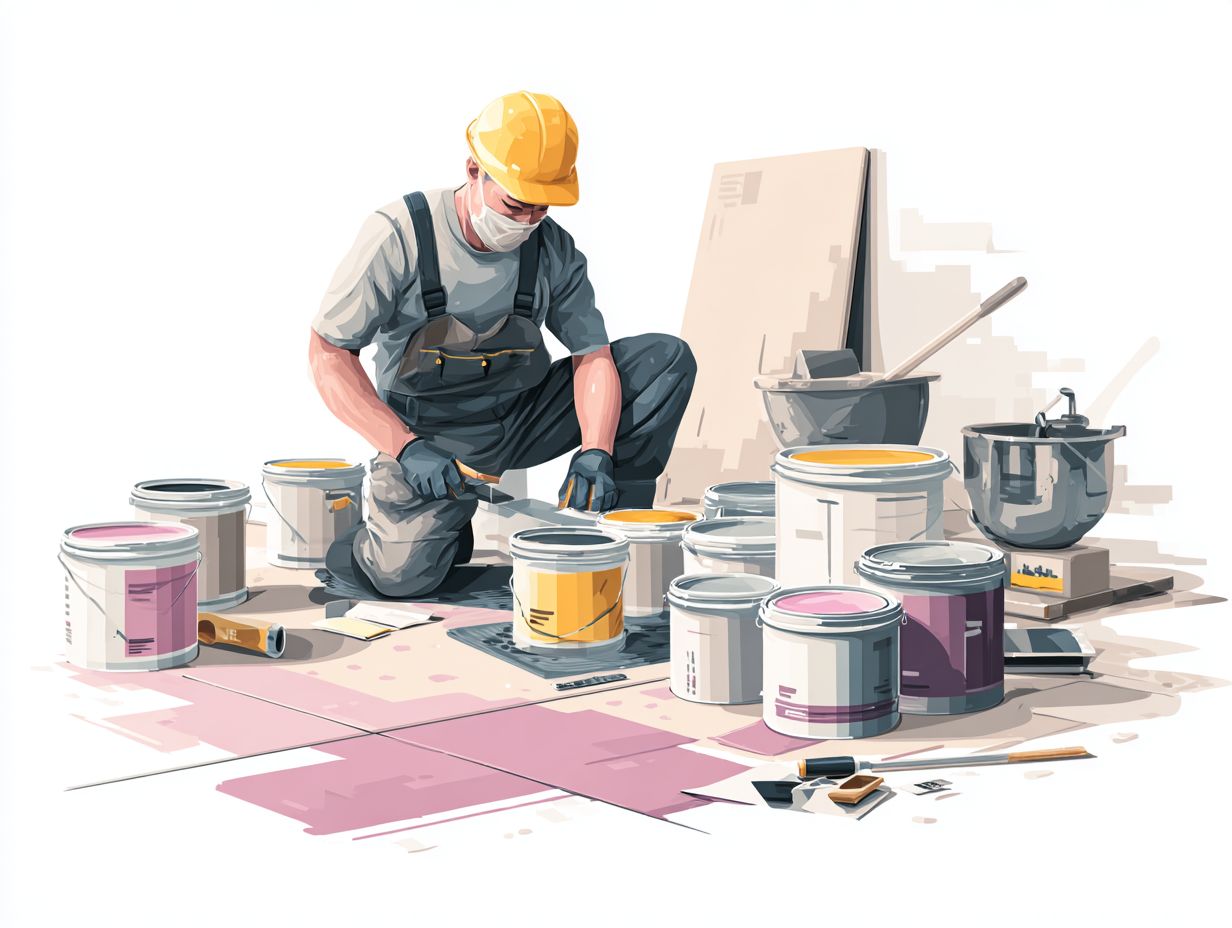
Knowing the drying and curing time of leveling compounds is necessary for scheduling the next steps in flooring installations and ensuring their effectiveness.
Typically, different types of leveling compounds have varying curing and drying times. For example, traditional cement-based compounds may take 24-48 hours to dry, while rapid-setting compounds can cure within 4-6 hours.
Factors such as ambient temperature and humidity significantly impact these times; warmer, drier conditions generally expedite drying. For the best results, keep the temperature at 70 degreesF (21 degreesC) and humidity below 60%.
Monitoring these conditions can help achieve the best outcomes for your flooring projects.
Common Issues and Troubleshooting
Even with thorough preparation and use, typical problems can occur when using floor leveling compounds, which need to be solved for successful results.
Cracking and Shrinkage
Cracking and shrinkage are common problems that can affect the integrity of floor leveling compounds, often resulting from improper mixing or curing.
To avoid these problems, make sure to mix the compound as the manufacturer instructs. Usually, this means stirring it well for 3-5 minutes until it is evenly mixed. Adjust moisture levels by using internal curing methods, like adding water-retaining agents, especially in dry environments.
Maintain optimal curing temperatures between 50 degreesF and 90 degreesF; for example, using heaters during cold spells or coverings to retain moisture can be effective. Consider adding substances that increase flexibility in the compound, which can help prevent cracking when under stress.
Uneven Surfaces
Despite using leveling compounds, uneven surfaces can still occur, often due to inadequate preparation or improper application techniques.
To troubleshoot uneven surfaces, start by checking the substrate for dirt or moisture, which can hinder adhesion.
If the surface feels gritty, consider sanding it down lightly and reapplying the leveling compound.
When measuring your compound, make sure to follow the manufacturer’s guidelines for proportions. Using the wrong ratios can cause problems. A power mixer can help achieve a uniform mixture, reducing the likelihood of air bubbles.
Use a ruler to check the surface when it has dried; spots that need more work can often be fixed with a thin layer of material.
Frequently Asked Questions
What are floor leveling compounds and what are they used for?
Floor leveling compounds are self-leveling materials used to create a smooth and level surface on uneven or damaged floors. They are commonly used as a base for flooring materials such as tile, hardwood, and carpet.
What are the different types of floor leveling compounds?
There are two main types of floor leveling compounds: cement-based and gypsum-based. Cement-based mixtures contain cement and sand and are tougher, making them a good choice for areas with lots of foot traffic. Gypsum-based compounds are made of gypsum and are better for filling in smaller imperfections and creating a smoother surface.
Can floor leveling compounds be used on any type of flooring?
Floor leveling compounds can be used on most types of flooring, including concrete, wood, and tile. However, you should talk to an expert to find out the right compound for your particular flooring material.
How do I apply floor leveling compounds?
Before applying the compound, make sure the surface is clean, dry, and free of debris. Mix the compound according to the manufacturer’s instructions and pour it onto the floor. Use a trowel or squeegee to spread the compound evenly and smooth out any bumps or uneven areas. Let it dry completely before installing your desired flooring material.
How long does it take for floor leveling compounds to dry?
The drying time for floor leveling compounds can vary depending on the type of compound and thickness of the application. In general, it can take anywhere from 1-6 hours for the compound to be walkable and 24-48 hours for it to fully cure and be ready for flooring installation.
What are the benefits of using floor leveling compounds?
Floor leveling compounds provide a cost-effective and efficient solution for correcting uneven and damaged floors. They also help to create a level surface for your flooring, which can improve its overall appearance and lifespan. Besides, floor leveling compounds are simple to use and work with many types of flooring materials.



